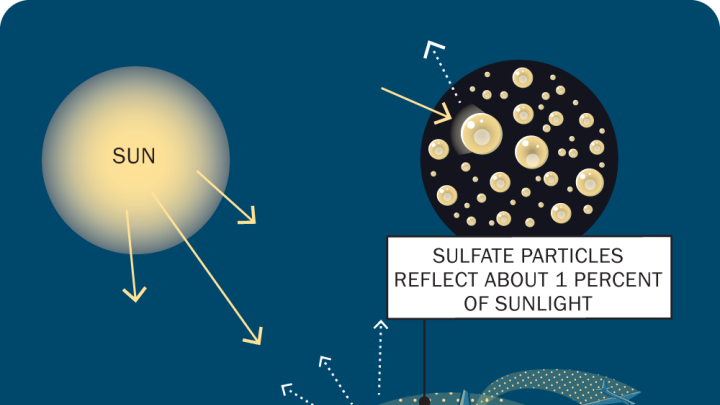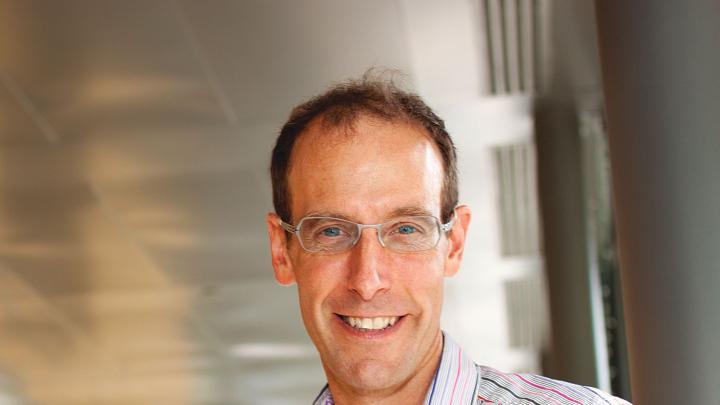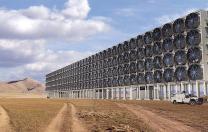David Keith talks fast and takes stairs two steps at a time, as though impelled by a sense of urgency. The Harvard scholar is interested in both the scientific and the public policy questions that bear on climate change and has a hand in a surprising range of projects related to climate and energy. He co-manages the Fund for Innovative Energy and Climate Research (FICER), established by Microsoft founder Bill Gates ’77, LL.D. ’07, to support innovative climate-change research, and has founded Carbon Engineering, a company that appears on track to build the first industrial-scale plant to capture carbon dioxide from the air for possible commercial use. But Keith is best known for his work on solar geoengineering: strategies to counter rising global temperatures by reducing the amount of sunlight that reaches Earth and its atmosphere. Such work might someday save the planet.
As skeptics continue to question whether global warming is real, and worldwide efforts to cut greenhouse gases stall, a small but growing number of scientists believe that humans may need to consider a “Plan B” that takes control of our climate’s future. Solar geoengineering encompasses multiple proposals to adjust the planet’s thermostat, including deflecting sunlight away from the earth with massive space shields or with extra-bright low-altitude clouds over oceans. One suggestion, inspired by sulfur-spewing volcanoes, involves modifying a fleet of jets to spray sulfates into the stratosphere, where they would combine with water vapor to form aerosols. Dispersed by winds, these particles would cover the globe with a haze that would reflect roughly 1 percent of solar radiation away from Earth. (The 1991 eruption of Mount Pinatubo, which shot some 10 million metric tons of sulfur into the air, reduced global temperatures about 1 degree F for at least a year.)
Scientists have discussed such strategies for decades, but (until recently) mostly behind closed doors, in part because they feared that speaking publicly about geoengineering would undermine efforts to cut greenhouse-gas emissions. Keith, who is McKay professor of applied physics in the School of Engineering and Applied Sciences (SEAS) and professor of public policy at Harvard Kennedy School, strongly advocates bringing discussion of geoengineering into the open. He says, “We don’t make good decisions by sweeping things under the rug.”
And even as he endeavors to publicize the geoengineering debate, Keith has also sought to move the science itself beyond computer models, toward the possibility of small-scale field-testing. “It is by no means clear what the right answer is, or how much, if any, geoengineering we should use,” he says, “but the balance of evidence from the climate models used to date suggests that doing a little bit would reduce climate risks.”
Constructing Consensus
By Keith’s account, the topic of solar geoengineering has transitioned in the last five years from an obscure area, studied by only a handful of what he calls “geonerds,” to a subject that draws increasing attention from both scientists and the general public. That lends Keith’s own publicizing efforts some of their urgency; he not only sees a need to “broaden the scientific community to avoid the risk of groupthink,” but also wants to help shape the conversation about these strategies and chart the course of related research.
He and fellow FICER administrator Ken Caldeira (of the Carnegie Institution for Science’s department of global ecology, at Stanford), have used the fund for projects that assess the risks of a warming planet and the benefits and risks of advanced technologies to address the problem. They’ve also used a small portion of the money to jumpstart the development of new technologies to deal with climate change. Not only are good solutions to the problem currently lacking, Keith says, but there is nothing approaching “a social consensus that it’s worth making serious efforts to solve the problem.”
Meanwhile, the world’s nations emitted an estimated 38.2 billion tons of carbon dioxide—the principal greenhouse gas, by volume—into the air in 2011, an increase of 3 percent over the previous year. This rate is expected to accelerate as developing nations such as China and India burn more coal and expand their vehicle fleets. In May, scientists reported that the average daily level of CO2 in the atmosphere surpassed 400 parts per million, a level last seen two to four million years ago. Even if humans miraculously halted all carbon emissions next week—an impossibility, and an economic catastrophe—the problem of climate change would still loom ahead: most of the heat-trapping gas will linger for decades or centuries. One study found that 40 percent of the peak concentration of CO2 would remain in the atmosphere for a thousand years after the peak is reached—and even then, inertia in the world’s warmed oceans will prevent a quick return to cooler temperatures.
“We have already committed ourselves to a certain level of warming in the future, whatever we do about our emissions,” says Andy Parker, a fellow in the science, technology, and policy program at the Kennedy School’s Belfer Center. The most optimistic predictions for the rest of the century, cited by the Intergovernmental Panel on Climate Change in its 2007 assessment report, forecast a rise of 2.0 to 5.2 degrees by 2100, while the direst anticipate a rise of 4.3 to 11.5 degrees. Among the anticipated effects are rising sea levels, increasingly severe storms and droughts, and melting glaciers and permafrost.
Given these projected long-term consequences of global warming, certain geoengineering strategies that seem to offer relatively quick-acting countermeasures could become especially attractive.
In 1992, Keith and his mentor Hadi Dowlatabadi, a physicist and applied mathematician, both then at Carnegie Mellon, wrote one of the first papers assessing geoengineering strategies. Today, the term is often used to refer both to removing CO2from the air (for re-use or for storage in reservoirs such as the deep ocean—see “Capturing Carbon,” page 26), and to limiting the amount of sunlight that reaches the earth in the first place (where it can be trapped in the atmosphere by greenhouse gases and contribute to warming).
Although these two strategies could work together to ease global warming, they have different costs and risks, and Keith argues against lumping them together. “We will have a better chance to craft sensible policy if we treat them separately,” he told a congressional committee in 2010. The massive scale of the CO2 problem means that carbon removal “will always be relatively slow and expensive,” he added. It carries some local risks, but has no chance of harming the entire planet. Solar geoengineering, in contrast, could work quickly—and at surprisingly low cost. (By recent estimates, spreading sulfur in the atmosphere to reduce global temperatures could cost a few billion dollars annually, a fraction of the projected cost of reducing greenhouse gas emissions. One 2006 review by the British government estimated that cutting emissions by 25 percent by 2050 would cost about 1 percent of annual global GDP, or about $1 trillion in 2050.) Keith argues that costs for solar geoengineering are so low that “cost will not be a decisive issue.” Instead, he says, scientists and policymakers will have to weigh risks: “the risk of doing it against the risk of not doing it.”
Keith speaks candidly about the risks and uncertainties of solar geoengineering, acknowledging a range of possible outcomes. “The balance of evidence so far suggests that solar geoengineering could reduce climate risks, but early science might be wrong,” he says. “We need experiments, which might show that it does not work.” Additionally, some research suggests that sulfate aerosols may further damage the ozone layer, an issue that he says needs further study.
Alan Robock, professor of environmental sciences at Rutgers, is one critic who has raised other concerns, theorizing that sunlight-blocking strategies could not only reduce the amount of electricity produced through solar power but also alter weather patterns, which might trigger widespread droughts. Keith does not find these possibilities convincing. He believes solar energy would be affected only in “extreme scenarios” with very heavy use of solar geoengineering, and he says he has not seen serious analysis that supports the possibility of drought. Studies have found that crop yields could increase in some regions, because plants grow more efficiently in diffuse light, and excess CO2 from the atmosphere could have a fertilizing effect. Yet one critical issue remains: solar geoengineering doesn’t address the underlying danger of CO2 emissions, which would continue to build up and create further problems, such as acidification of the oceans, which harms coral reefs and other marine life.
Above all, the techniques currently proposed would have to be applied gradually, to limit drastic climate changes. That presents knotty governance challenges—requiring diverse nations (and political groups within those nations) to agree on a joint course of action, something they have been largely unable to do when negotiating treaties to address greenhouse-gas emissions. “With solar geoengineering, at some level you’ve got just one knob,” Keith says. “That demands collective global decisionmaking.”
And yet solar geoengineering’s relatively low cost raises the possibility that a single nation, or perhaps a group of island nations threatened by rising seas, could act unilaterally to initiate it. “One small group of people can have a lot of influence over the entire planet,” Keith says. But he does not view this as an inexorable threat. “If some crazy group decides they’re going to start flying airplanes and putting sulfur in unilaterally,” he says, “it’s not that hard to stop.” Still, he’s concerned. “I think the underlying brute reality”—that solar geoengineering “does seem to provide a significant way to reduce climate risk at very low cost—is going to be very powerful,” Keith says, “and I think it’s going to be hard to stop people from rushing to do it. I’m not eager to see things go faster.”
In light of these caveats, Keith laments that some journalists and scholars depict him as a “techno-optimist” cheerleader for these technologies. The reality, he says, is that he’s hopeful about technical innovation, “but deeply pessimistic about human behavior when it comes to protecting the natural world. It’s convenient for critics to pigeonhole me as a booster and cite some skeptical social scientist on the risks,” he says, but he and fellow researchers in the field “have usually been the first to voice concerns about risk and governance challenges.”
Difficult Conversations
In 2007, Keith, then at the University of Calgary, and Daniel Schrag—professor of environmental science and engineering, and director of the Harvard Center for the Environment—invited a group of environmental scientists and policymakers to Cambridge for a daylong workshop on geoengineering. The meeting was held off-campus and closed to the public.
Keith and Schrag also invited three science journalists, who were permitted to write about the discussion, but couldn’t quote participants without their consent. Keith believes this is a useful way to run early meetings on new and controversial topics. “People need time to figure out what their opinion is, and to say things that they’re not sure about,” he explains. “If everything’s public, you don’t have the freedom to say ‘Maybe it’s a nutty idea, but maybe we should do X, or maybe we should do Y.’ For a thing like this, if it’s all out in public, you shut people down, and they’re not free to engage in a give-and-take.”
Although this wasn’t the first major meeting about geoengineering, it was among the first to include social scientists and policymakers. “There was an excitement about confronting all these mind-blowing issues,” remembers professor of economics Martin Weitzman, an attendee who believes the meeting changed some minds. He recalls a range of opinions: participants who believed geoengineering technologies should be used as a first line of defense against global warming, others who felt strongly that scientists shouldn’t even discuss such strategies, and most people “arrayed between those extremes.” Weitzman says the meeting crystallized his sense that initial research should proceed to prepare for emergencies, such as unilateral action by a rogue nation. He calls geoengineering “a scary proposition,” but adds, “It’s better to be informed than to be…caught unaware.”
Keith himself was particularly struck by a point made at that 2007 conference by Eliot University Professor Lawrence Summers, who warned against withholding information about global-warming solutions, or prejudging how the public might react to these ideas. “I don’t think scientists by virtue of being scientists have deeper political insight or more moral weight,” Keith says. “The idea that we as a scientific class should decide what the rest of society is able to handle is really obscene, and I think that Larry was very clear about that.”
But even as Keith considers public participation essential to a geoengineering conversation, he recognizes the need for public education beforehand. That brings the issue of small-scale field-testing into play. Experimentation is necessary to determine whether an aerosol solution is even viable. He’s currently working with Weld professor of atmospheric chemistry James Anderson to develop a test that would send a helium balloon bearing small quantities of sulfur and water into the stratosphere, to monitor how they affect ozone; previous research has shown that sulfur and water vapor react with atmospheric chlorine, changing it to aform that damages ozone. The experiment would likely use just a couple of kilograms of sulfate particles and would have no effect on the climate, Keith says. Its impact “will likely be much less than a single commercial airline flight.”
But the study may be a long time coming, in part because such research is so controversial. Some critics say field tests should be banned because they are the first step down a slippery slope toward full-scale solar geoengineering. Keith emphasizes that he and Anderson will not move forward without public assent: “We will not do [our study] unless we have some formal governmental approval and public funding.”
Indeed, he hopes that the study, beyond its scientific aims, will also help establish a structure to govern similar small-scale research in the future. This spring, he and Edward Parson of the UCLA School of Law called for government oversight of geoengineering research; they say that self-regulation isn’t sufficient to manage the risks. But in place of a treaty, they suggest a nonbinding set of norms issued jointly by scientific bodies in the United States, Europe, and China: “sensible principles about how to manage risk, and about transparency and openness,” Keith says (see “Governing Geoengineering Research,” page 26). He would also like to see an international moratorium on large-scale deployment. Without broadly accepted governance, Keith says, field research will remain deadlocked. Funding agencies won’t support experiments that lack a system of oversight, but such systems won’t be created unless scientists are ready to conduct experiments.
Climate-Change Costs
Keith admires a quote on the Albert Einstein Memorial at the National Academy of Sciences in Washington, D.C.: “The right to search for truth implies also a duty; one must not conceal any part of what one has recognized to be true.”
As a leader in his field, Keith’s conclusions have at times run counter to accepted wisdom. For example, many scientists who investigate and think about solar geoengineering stress that the emphasis on cutting global greenhouse gas emissions must not change, even if research reveals that geoengineering strategies are worth pursuing.
Keith disagrees. He points out that many policymakers and scholars weigh climate-change solutions in terms of risks and costs, comparing, for example, the cost of climate damages to the cost of cutting emissions. “The money we spend cutting emissions will save money in climate damages,” Keith says, and he believes we should spend much more on current emissions-slashing efforts. But he points out, “If you reduce the risk even a little bit with solar geoengineering, then in a perfect world you should be able to put a little less money into cutting emissions,” thereby alleviating some of the daunting trillions in costs anticipated for future greenhouse-gas mitigation efforts.
Some researchers say they hope solar geoengineering technologies are never deployed, but Keith objects to this automatic discomfort about manipulating the planet. He hopes to foster a more nuanced debate. “I think there are lots of things that are scary about this prospect, but I just don’t see how finding a potentially life-saving technology that helps to reduce climate risk a lot is awful,” he says. “I just don’t see that.”









